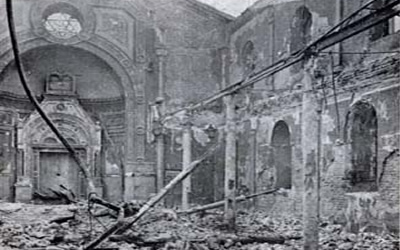The Legionnaires' rebellion and the Bucharest pogrom occurred in Bucharest, Romania, between 21–23 January 1941. As the privileges of the Iron Guard paramilitary organization were being cut off gradually by the Conduc?tor Ion Antonescu, its members, also known as the Legionnaires, revolted. During the rebellion and pogrom the Iron Guard killed 125 Jews.
The Bucharest pogrom was not a side effect of the rebellion, but a parallel event, purposefully organized to give legitimacy to the rebellion and to equate the Legionnaires' opponents with Jewish sympathizers. Many parties took part in the riots against the Jews: police officers loyal to the Legionnaires, various Legionnaire organizations, the workers' union, student union, high-school students, Roma and Sinti and criminals. The attacks on the two Jewish boroughs (Dude?ti and V?c?re?ti) began a few hours before the rebellion. Minister Vasile Iasinschi gave the order to set the Jewish neighborhoods on fire, and mobs stormed Jewish homes, synagogues and other institutions. The Legionnaires' headquarters became torture centers, and Jews kidnapped from their homes were brought to them. Jews' homes were set on fire and the Jews themselves were concentrated in places where they could be tortured to take their property. Jews were murdered at random, but also in planned executions. Some Jews were thrown from the top floors of the police headquarters building, and others killed in the slaughterhouse.
Besides extorting the Jews for their hidden property, sadistic youth (including teenagers) took part in the torture, for their own pleasure. It continued for hours and even days and nights, the torturers taking turns. Jews were robbed of any possessions on their person, and sometimes even their clothes. They were made to turn over property hidden elsewhere, private or communal, and were often shot afterwards, as happened to the community's treasurer. Some Jews were coerced into writing suicide notes before being killed.
The persecutors were headed by Mircea Petrovicescu, the son of the minister of the interior who was deposed by Antonescu. Petrovicescu tied Jews to targets and shot them, aiming not to hit them but to draw a line around them. Legionnaire women took part in the pogrom; all survivors noted their involvement in the torture, and some of the worst acts of abuse were at their hands.
On 23 January, a few hours before the rebellion was quelled, a group of Legionnaires selected 15 Jews at random. They took them in trucks to the local slaughterhouse, where they were shot. Five of the Jews, including a five-year-old girl, were hung on the slaughterhouse's hooks, still alive. They were tortured, their bellies cut and their entrails hung around their necks in a parody of shehita, kosher slaughter of cattle. The bodies were labeled "kosher". The slaughterhouse was closed for a week to purge and clean the house of the results. When Antonescu appointed a military prosecutor to investigate the events at the slaughterhouse, he reported that he recognized three of his acquaintances among the "professionally tortured" bodies (lawyer Millo Beiler and the Rauch brothers). He added, "The bodies of the dead were hanged on the hooks used by slaughterers.
American minister to Romania, Franklin Mott Gunther, toured the meat-packing plant where the Jews were slaughtered with the placards reading "Kosher meat" on them. He reported back to Washington: "Sixty Jewish corpses were discovered on the hooks used for carcasses. They were all skinned . . . and the quantity of blood about was evidence that they had been skinned alive". Gunther wrote he was especially shocked that one of the Jewish victims hanging on the meat hooks was a five-year-old girl, saying that he could not imagine such cruelty was possible until he saw the evidence of it firsthand.
Of the slaughterhouse episode, Romanian author Virgil Gheorghiu later wrote:
In the big hall of the slaughterhouse, where cattle are hanged up in order to be cut, were now human naked corpses . . . On some of the corpses was the inscription "kosher". There were Jewish corpses. … My soul was stained. I was ashamed of myself. Ashamed being Romanian, like criminals of the Iron Guard.
During the pogrom 125 Bucharest Jews were murdered: 120 bodies were eventually counted, and five never found. Other Jews, not from the Bucharest community, who happened to be in Bucharest at the time may have also been killed. The Legionnaires ignited the Jewish synagogues and danced around the flames, roaring with joy. To accomplish their mission they used a fuel tanker, sprayed the walls of Kahal Grande (the great Sephardic synagogue) and lit it. It was completely burnt. In the various synagogues the Legionnaires robbed the worshipers, abused them, took all their valuables and tore up the holy scriptures and ancient documents. They destroyed everything, even the lavatories.
During the riots 1,274 businesses, shops, workshops and homes were badly damaged or destroyed. After the suppression of the rebellion, the army took the Legionnaires' loot in 200 trucks (not including money and jewelry). Some synagogues were partly saved. The large Choral Temple (Heichal Hakorali) synagogue was saved from burning completely, because the Legionnaires didn't bring enough fuel.





No Comments found